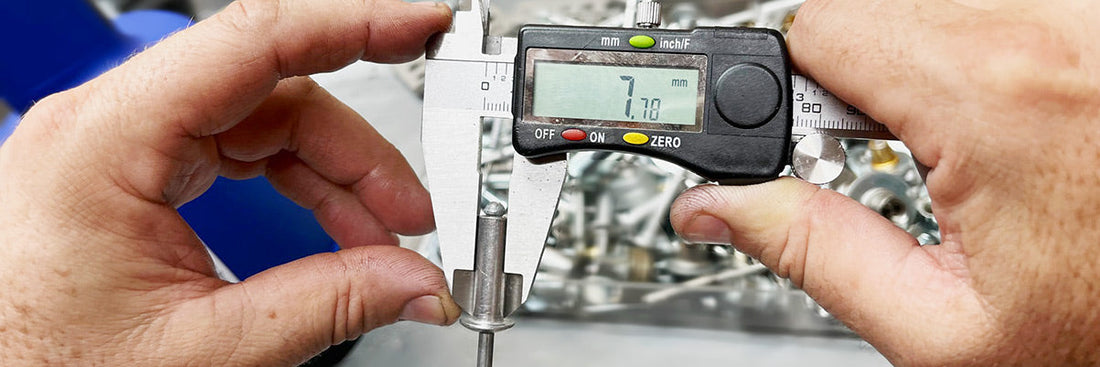Choosing the right rivet starts with knowing how to measure it correctly. While it might seem straightforward, rivet sizing—especially when it comes to the body—can be confusing. Is it the diameter? The length? And what exactly is "grip range"?
In this quick guide, we’ll show you how to measure the rivet body accurately and explain what those measurements mean, so you can select the right rivet every time.
What Exactly Are You Measuring?
A rivet has two main parts:
- The Body (Eyelet): The cylindrical section that goes through the materials being joined.
- The Mandrel: The stem that’s pulled during installation to expand the body and form a secure joint.
When we talk about “measuring a rivet,” we’re mainly focusing on the body, since it determines what size hole you need and what material thickness the rivet can handle. The mandrel’s diameter and length are less critical, as they vary between manufacturers and are discarded after installation.

Measuring Rivet Body Diameter
Use a calliper to measure the diameter across the body (not including the domed tip of the body). This measurement determines the required hole size. Common diameters include:
- 1/8" (3.2mm)
- 5/32" (4.0mm)
- 3/16" (4.8mm)
- 1/4" (6.4mm)
- 5/16" (7.95mm)
- 3/8" (9.53mm)
Tip: The hole should be slightly larger than the diameter of the rivet body. For example, a 4.8mm rivet may need a Ø5.0mm hole. Always refer to the manufacturer’s datasheet for the recommended hole size.
Measuring Rivet Body Length
Measure the length of the rivet body from under the flange to almost the end of the shank, but do not include the domed tip of the body in this measurement.
- Body length affects the grip range. Generally, the longer the body, the rivet can grip thicker materials, but not always. We will explain the difference between grip range and body length in the next section.
- A longer body doesn't mean a better fit. You want a correct grip range, not excess length.
Customers often ask about the protrusion of the body after installation (on the blind side). There’s no fixed answer – this varies depending on the material thickness and how the rivet is installed. We strongly recommend testing before full-scale installation if clearance is a concern.
Grip Range vs. Body Length
This is where many people get tripped up: grip range is not the same as body length.
Grip Range is the total thickness of materials the rivet is designed to fasten. It is the most important factor to consider when selecting a rivet, not the body length. It’s usually shorter than the body length, allowing room for proper expansion and bulge formation.
There’s no industry-wide standard for grip range, so always check the manufacturer’s data sheet for each rivet model.
Real-World Examples:
Let's look at a couple of examples to put it all together:
Rivetlab Rivlok® SRDR-0604:
- "06" means 3/16" (4.8mm) body diameter
- "04" refers to the grip range, e.g., 1.6-6.4mm
- The body length is 10.5mm, which is slightly longer than the max grip to allow proper forming
For a Huck Magna-lok® rivet MGLP-R8-6:
- "R8" means steel 1/4" (6.4mm) body diameter
- "6" refers to the grip range, e.g., 2.0-9.5mm
- The body length is 14.2mm, which is a bit longer than 9.5mm
Knowing how to interpret this helps you avoid guesswork and ensures a proper, long-lasting joint.
Final Tips for Measuring Rivets
- Always use a digital calliper for accurate results.
- Don’t confuse body length with overall length (which includes the mandrel and the domed tip).
- Confirm your material thickness and match it to the grip range, not body length.
- Keep a few spare samples or a rivet size chart on hand for reference.
Need Help Choosing the Right Rivet?
At RivetLab, we stock a wide range of structural and pop rivets from leading brands like Huck®, FAR®, and POP®—each with clearly defined specs, grip ranges, and datasheets to help you make the right choice.
Got questions? Our team is here to help. Contact us or browse our range of rivets by size today.


